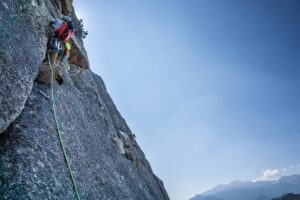Lead climbing, alternatively known as ‘leading’, denotes an advanced climbing technique wherein the climber attaches their rope to the climbing protection as they navigate upwards on the climbing path. Meanwhile, their secondary partner, the belayer, maintains his position at the foot of the course, vigilantly managing the rope to guard the primary climber should there be a descent. This term separates the distinct roles and also highlights the escalated duty and amplified risk associated with the function of the lead climber.
This form of ascent is starkly contrasting with top roping, an alternative method wherein, despite the continued presence of a belayer, the lead climber encounters minimal peril in case of a fall. In this approach, there’s no necessity to hitch the rope to protective devices, given the pre-fixed anchoring of the rope atop the route, ensuring the climber is suspended from the rope in the event of a fall.
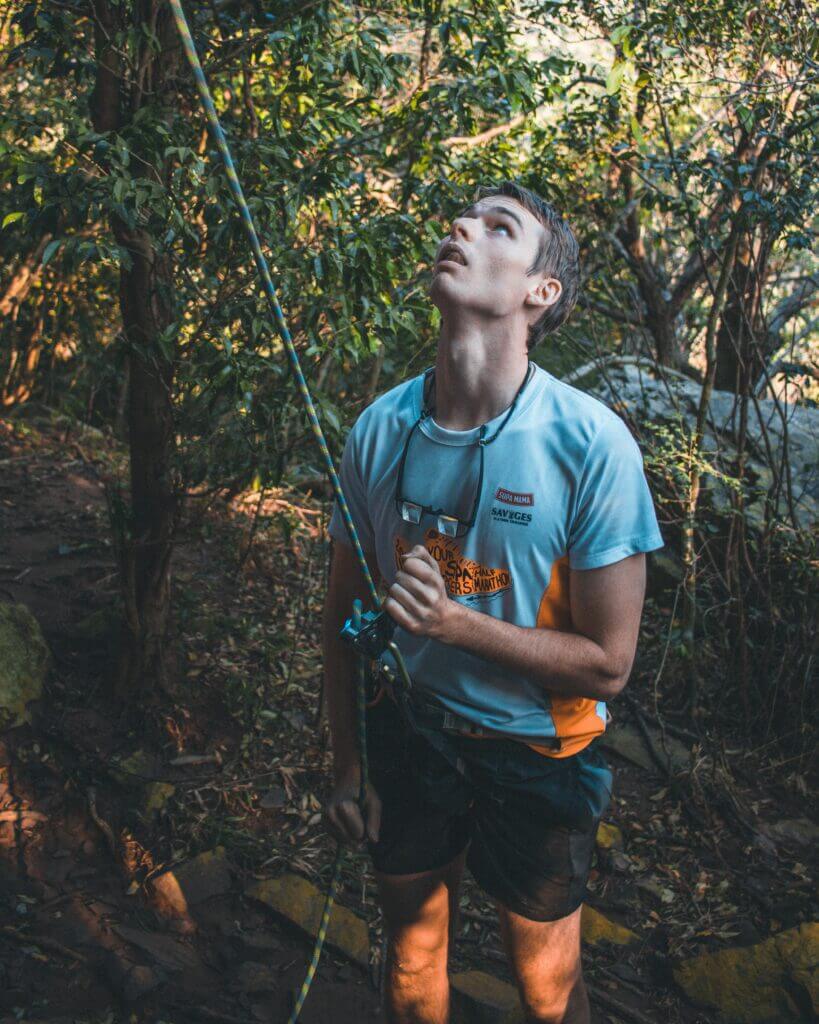
Lead climbing can be carried out as free climbing in two distinct formats: traditional climbing or sport climbing. Undertaking traditional lead climbing proves particularly precarious, requiring increased physical exertion. Competition-based lead climbing, a subset of the broader sport climbing category, is now internationally recognised as an Olympic sport.
The technique can also be explored through aid climbing, although it is not typically associated with solo free climbing— considering the solo climber does not require to distinguish between roles, as they undertake the endeavour autonomously.
Understanding the Risks and Rewards of Leading
Understanding the Risks and Challenges
Embarking on a climbing lead, the trailblazer secures their rope into the allocated climbing safeguard as the journey unfolds. In the context of a traditional climbing expedition, the foremost climber is entrusted with the responsibility of arranging and embedding temporary climbing protectors as the ascent progresses. On the other hand, for a sport climbing route, the requisite climbing safeguards are pre-installed courtesy of pre-drilled bolts. The principal climber is only mandated to fasten quickdraws on these routes.
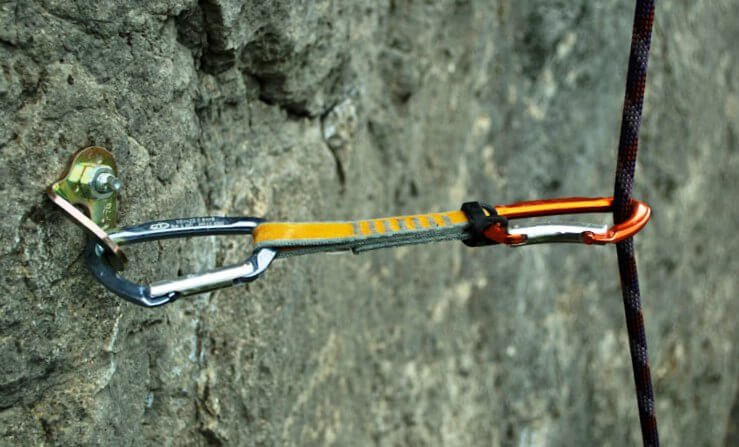
Consequently, it is perceptible to infer that leading a traditional route epitomises a venture that is innately more precarious and physically exigent in comparison to a sport climbing route of identical grade.
A singular additional intrinsic risk factor associated with traditional climbing apart, any leading climber inherently confronts the specific peril of tumbling twice the distance to their last safeguard. Simply put, if the premier climber is a three-metre radius above their last security point, a potential fall will result in a six-metre detriment, culminating in the climber resting three metres beneath the last security point. Therefore, it can be deduced that this facet of leading considerably augments physical demand over that experienced in top roping.
Moreover, ascending a climb demands proficient communication between the leading climber and his second – the belaying party. Notably, the leading climber should ensure their partner does not hold onto the rope with unduly tightness, as this spawns “rope drag,” functioning as a descending force on the lead climber. Conversely, if the lead climber perceives an impending tumble, they would prefer their partner to promptly retract any slack in the rope to attenuate the amplitude of the prospective fall.
Lead Climbing: Understanding First Ascents & Climbing Grades
The inclination and determination to spearhead a climb correlate with the concept of what constitutes a first ascent (FA), or a first free ascent (FFA), in both traditional and sport climbing disciplines. The difficulty ratings assigned to these climbing routes hinge on the climber leading the ascent, as opposed to top roping. Climbers who wish to gauge their proficiency at a specific technical grade or seek to establish a new grade benchmark are required to lead the route.
Prior to the advent of sport climbing in the early 1980s, traditional climbers viewed FFAs with scepticism if the leading climber had previously rehearsed the route on a top rope, a method known as ‘head pointing’. More contentious still was practising the strenuous, pivotal moves from a suspended fixed rope, a tactic termed ‘hang dogging’. However, the emergence of sport climbing resulted in the acceptance of the ‘redpoint’ as the standard definition of an FFA, accommodating the practices of head pointing and hang dogging.
On the occasion that a lead climber triumphs in navigating a route on the initial attempt without any preceding knowledge, this feat is referred to as an ‘onsight’; or, if briefed beforehand, a ‘flash’. This manner of ascent continues to be regarded as the most commendable achievement.
Essential Gear for Lead Climbing: From Harnesses to Quickdraws
Regardless of the style – be it traditional, sport, or aid – the lead climber should be equipped with a harness affixed to a dynamic rope, typically via a figure-eight knot. The partner, in the role of belayer, utilises a mechanical belay device. This is clipped into the rope, allowing the rope to be paid-out as required, and securely holds the rope to catch the leader should a fall occur.

In the traditional climbing format, the lead climber carries a variety of protective equipment. This can encompass items such as nuts, hexcentrics and tricams, also referred to as “passive” protection, and/or spring-loaded camming devices or “friends”, known as “active” protection. Conversely, sport climbing necessitates only that the lead climber carries quickdraws to clip into the fixed bolts.
For both sport and traditional leading, the inventory varies:
Sport Leading:
- A variable amount of Quickdraws, dependent on the number of bolts along the route
- Equipment to construct an anchor
Traditional Leading:
- A selection of removable gear, such as nuts and cams
- Quickdraws, the number of which is determined by the length of the route
- Equipment to build an anchor
Regardless of whether it is sport or traditional, the lead climber is expected to possess the knowledge and necessary equipment to construct and dismantle an anchor at the pinnacle of the climb. The geographical nature of the climb dictates the specific gear required and the type of anchor intended to be built. Requirements can range from several quickdraws to a cordelette and numerous locking carabiners.
Understanding and Mitigating Risks
Beyond the unique hazards inherent to positioning provisional safety apparatus during a traditional lead climb, the front-runner must handle various broad risk zones as the climb progresses:
The term ‘runout’ refers to the gap between the vanguard climber and their last installed safety point. A greater runout equates to a longer potential distance of a fall and consequently increases the psychological strain on the climber. Certain leadership challenges incorporate runouts where a fall is synonymous with a ‘ground-fall’, where the climber experiences a direct impact on the ground.
‘Back-clipping’ denotes the scenario where the rope is fastened into a quickdraw in such a manner that the leader’s end of the rope percolates beneath the quickdraw carabiner rather than above it. Should a fall transpire, the rope may be prone to snapping over the carabiner gate, compelling it to open, which could yield disastrous results.
‘Z-clipping’ refers to the incidence where a lead climber seizes the rope beneath an already attached quickdraw and secures it into the subsequent quickdraw. This results in an irregular ‘zig-zag’ pattern of rope on the wall, potentially creating significant rope friction and preventing further progress until corrected.
‘Turtling’ is defined as a scenario when one of the leading climber’s limbs is entangled behind the rope as they lose grip of the ascent, potentially leading to the climber inverting. This scenario shares similarities with a turtle on its back and holds the risk of the climber being jettisoned from its harness.
A Guide to Risk Management
Whilst eradicating all risks from lead climbing is unattainable, there exist measures to manage these potential dangers:
Accomplish suitable training: It is crucial that both the lead climber and belayer are adequately trained in lead climbing techniques.
Procure a vigilant belayer: The belayer plays an integral role in lead climbing, and the climber should only embark on the ascent with someone who is both trustworthy and proficient in lead-belaying techniques. Further information on proficient lead belay technique can be found in our article, ‘How to Belay a Lead Climber’.
Assess potential consequences: Both the climber and belayer must contemplate the possible repercussions of a fall at every stage of the route. Are there substantial ledges in the climber’s prospective fall trajectory or is it possible that a fall could land the climber back at the ground level?
Inspect climbing equipment: An examination of bolts and gear placements is essential to provide assurance of their security.
Avoid rushing into arduous challenges: It is typical for climbers to strive to push their boundaries and attempt increasingly demanding lead climbs, a central part of the adventure’s appeal. However, it is essential to progress gradually. In the early stages, a cautious approach should be maintained, and straightforward routes should first be mastered.
Mastering Controlled Falls in Lead Climbing: A Key to Confidence and Skill
Executing controlled descents in low-risk environments and robust equipment can be entirely safe, providing an excellent avenue for enhancing your confidence and proficiency. It is prevalent amongst sport climbers to undertake repeated head climber falls while deciphering the steps on a complex route. Having a comfortable attitude towards descending interprets trust in the equipment and your belayer, thus enabling increased climbing difficulty.
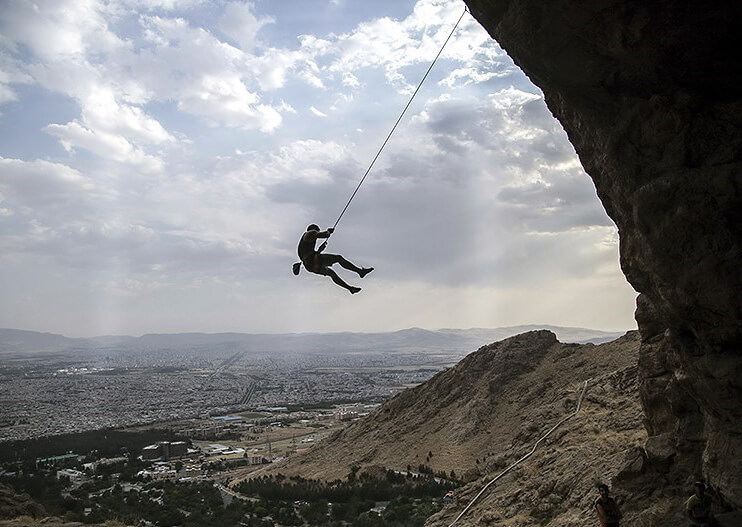
Traditional climbers typically exercise a more prudent attitude towards falling. However, adequately positioned stoppers and cams can efficaciously arrest a fall on par with a sturdy bolt.
In addition, controlling a descent in a supervised scenario is an excellent form of practice for a head belayer. It allows the belayer to hone their skills in maintaining an adequate degree of slack in the rope and safely arresting falls.
Acquire further knowledge about falling in our detailed commentary, ‘Lead Climbing: Mastery of the Descent.’
Understanding Multi-Pitch Climbing and Simul Climbing Techniques in Lead Climbing
Lengthy ascents, akin to those encountered during large wall climbing, are typically tackled in a series of pitches, each roughly spanning from 35 to 50 metres. In this style of multi-pitch lead climbing, the dual roles of lead climber and secondary climber can be interchanged in subsequent stages. The climber in the second place should take comfort in operating from a suspended belay, whilst both climbers ought to be adept in the manner of swapping roles in a safe and efficient manner. Given their longer overall length and the heightened likelihood of poorer weather conditions, it is imperative that climbers maintain clear communication channels. Their verbal commands must be understood unambiguously by both parties involved.
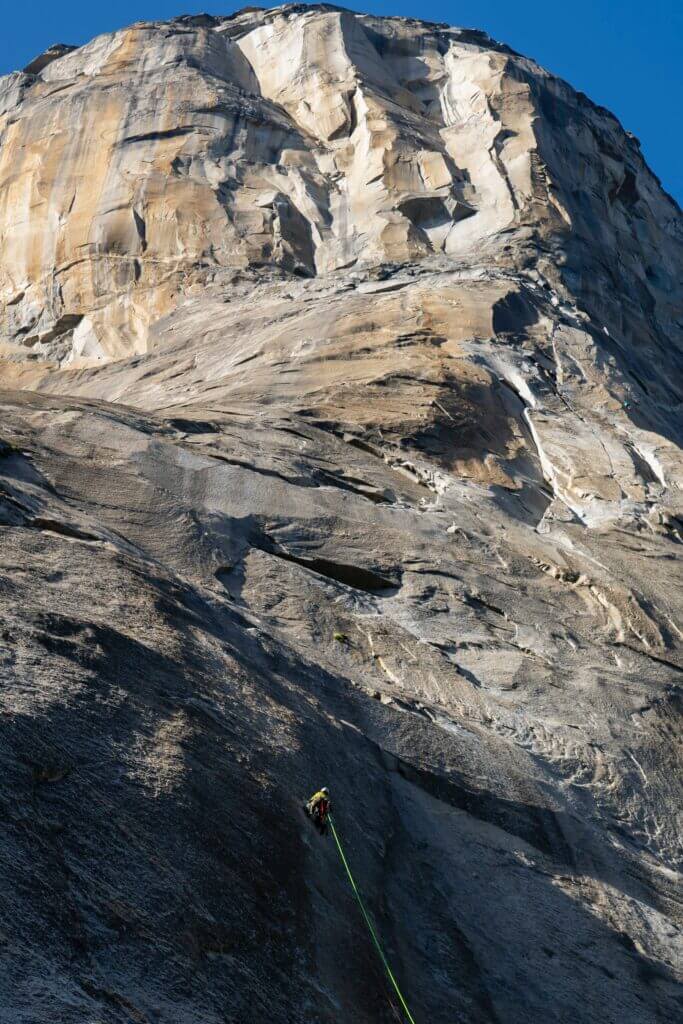
On longer routes of lesser difficulty, climbers may opt for simultaneous ascent, also called simul-climbing. This involves both climbers ascending the route in unison. The lead climber’s actions mirror those of a typical lead climb, while the secondary climber, rather than holding a static belay position, also engages in the climb. As they ascend, the second climber removes or unclips the lead climber’s protection apparatus. The climbers are constantly tied to the rope and ensure that multiple protection points are in place between them at all times. Simul-climbing is only pursued when both climbers feel confident on the terrain, as a fall could yield serious consequences. It is a common strategy for the more proficient climber to opt for the secondary position.
Evolution of Competition Lead Climbing: From Sportroccia to the Olympics
The safer format of sport climbing witnessed an evolution in the early 1980s, which triggered a notable expansion within the sphere of competitive lead climbing. The genesis of the chief worldwide competition in lead climbing occurred in Italy at Sportroccia in 1985.
As the century advanced towards the late 1990s, additional fields of competitive bouldering and competitive speed climbing were introduced, paving the way for the annual institution of the IFSC Climbing World Cup and the biennial constitution of the IFSC Climbing World Championships. Competition lead climbing made its debut in the 2020 Summer Olympics for both men and women, albeit with an uncommon format. The categories of lead, bouldering and speed climbing were bundled into a single medal event ambiguously designated as “sport climbing”.
Taking the First Steps into Lead Climbing: A Practical Guide
Preparing for Lead Climbing: Emphasizing Adequate Training
Enrol in specially designed courses or seek guidance from reliable guide companies or a dependable companion. Prior to embarking on a lead climb, ensure a robust understanding of traditional gear placement should one wish to tackle a traditional climb. Furthermore, proficiency in quickdraw clipping, leader belaying, effective rope management and construction of anchors is an essential prerequisite. These skills underpin the particularly challenging endeavour that is lead climbing, so their mastery warrants careful attention. Achieving competence in these areas requires rigorous training and meticulous practice is advocated to enhance an individual’s climbing prowess and safety vigilance.
Evaluating Your Psychological Preparedness for Lead Climbing
Prior to embracing the daunting challenge of lead climbing, one must scrutinise their mental preparedness. A degree of caution is necessary when comrades impulsively spur you on without genuinely evaluating your experience and technical abilities. To successfully undertake lead climbing requires an array of skills; gear clipping, meticulous rope management, and the gravitas to climb above gear, tasks that are redundant in top-roping scenarios.
Lead climbing can undoubtedly induce trepidation, and confessing to this apprehension is nothing to be embarrassed about. If the mind is not harmonised with the task at hand, it is more sensible to steadily enhance one’s skills and seize every chance to apprentice oneself to an experienced lead climber. This presents a rare chance to examine gear placements, refine techniques, and inch ever closer to being poised to tackle this thrilling activity.
Practising Your First Lead Climb with a Mock Lead Approach
Ideal for novice lead climbers is to undertake a simulated lead climb. A simulated lead climb involves ascending a route using a top rope while concurrently leading with another rope. This technique facilitates concentrating on key aspects such as the insertion of equipment, attaching to bolts and rope management, all within the safety net of a top rope to arrest any potential falls. Performing a simulated lead climb necessitates two ropes and a pair of belayers.
Getting Started with Your First Lead Climb: Essential Tips and Considerations
When preparing to embark on a maiden lead climb, one must bear in mind these points of consideration:
It should be no cause for embarrassment to choose a route frequented by novice climbers. This serves as a humble acknowledgement of one’s inexperience and the learning curve that lies ahead.
Equally, it’s crucial to remember that the ability to ascend a 5.10 route whilst using top rope equipment does not necessarily translate into an aptitude for lead climbing at the same intensity.
The controlled environment of a climbing gym can offer an excellent launchpad for learning lead climbing skills. However, it’s essential to understand that venturing outdoors will demand skills in building and cleaning an anchor, tasks not required in the confines of a gymnasium.
Finally, it would be beneficial to begin on a route where a sense of complete stability and control is achievable. This will provide the chance to focus fully on vital skills such as gear placement, bolt clipping, and rope management – all crucial aspects of a successful climb.

